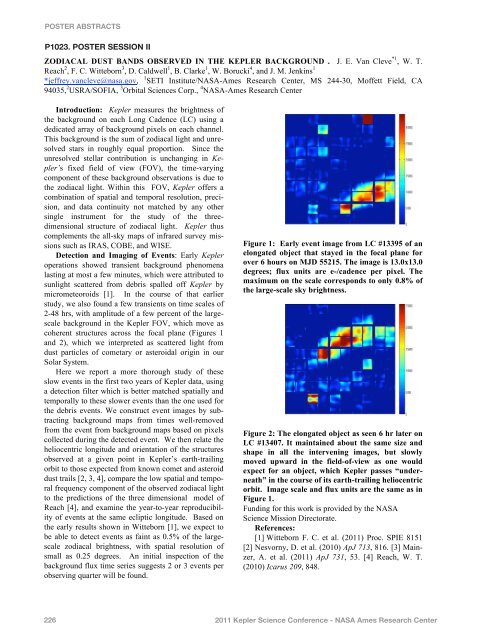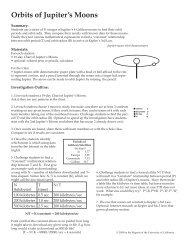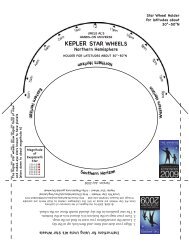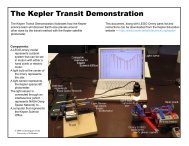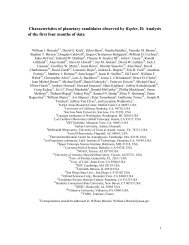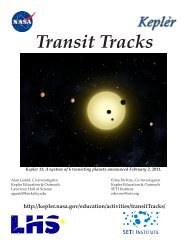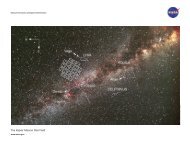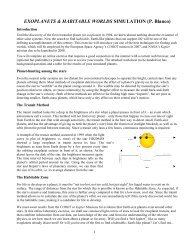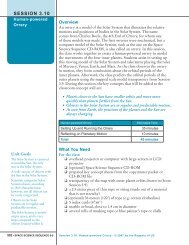Poster Abstracts - Kepler - NASA
Poster Abstracts - Kepler - NASA
Poster Abstracts - Kepler - NASA
- No tags were found...
Create successful ePaper yourself
Turn your PDF publications into a flip-book with our unique Google optimized e-Paper software.
POSTER ABSTRACTSP1023. POSTER SESSION IIZODIACAL DUST BANDS OBSERVED IN THE KEPLER BACKGROUND . J. E. Van Cleve *1 , W. T.Reach 2 , F. C. Witteborn 3 , D. Caldwell 1 , B. Clarke 1 , W. Borucki 4 , and J. M. Jenkins 1*jeffrey.vancleve@nasa.gov, 1 SETI Institute/<strong>NASA</strong>-Ames Research Center, MS 244-30, Moffett Field, CA94035, 2 USRA/SOFIA, 3 Orbital Sciences Corp., 4 <strong>NASA</strong>-Ames Research CenterIntroduction: <strong>Kepler</strong> measures the brightness ofthe background on each Long Cadence (LC) using adedicated array of background pixels on each channel.This background is the sum of zodiacal light and unresolvedstars in roughly equal proportion. Since theunresolved stellar contribution is unchanging in <strong>Kepler</strong>’sfixed field of view (FOV), the time-varyingcomponent of these background observations is due tothe zodiacal light. Within this FOV, <strong>Kepler</strong> offers acombination of spatial and temporal resolution, precision,and data continuity not matched by any othersingle instrument for the study of the threedimensionalstructure of zodiacal light. <strong>Kepler</strong> thuscomplements the all-sky maps of infrared survey missionssuch as IRAS, COBE, and WISE.Detection and Imaging of Events: Early <strong>Kepler</strong>operations showed transient background phenomenalasting at most a few minutes, which were attributed tosunlight scattered from debris spalled off <strong>Kepler</strong> bymicrometeoroids [1]. In the course of that earlierstudy, we also found a few transients on time scales of2-48 hrs, with amplitude of a few percent of the largescalebackground in the <strong>Kepler</strong> FOV, which move ascoherent structures across the focal plane (Figures 1and 2), which we interpreted as scattered light fromdust particles of cometary or asteroidal origin in ourSolar System.Here we report a more thorough study of theseslow events in the first two years of <strong>Kepler</strong> data, usinga detection filter which is better matched spatially andtemporally to these slower events than the one used forthe debris events. We construct event images by subtractingbackground maps from times well-removedfrom the event from background maps based on pixelscollected during the detected event. We then relate theheliocentric longitude and orientation of the structuresobserved at a given point in <strong>Kepler</strong>’s earth-trailingorbit to those expected from known comet and asteroiddust trails [2, 3, 4], compare the low spatial and temporalfrequency component of the observed zodiacal lightto the predictions of the three dimensional model ofReach [4], and examine the year-to-year reproducibilityof events at the same ecliptic longitude. Based onthe early results shown in Witteborn [1], we expect tobe able to detect events as faint as 0.5% of the largescalezodiacal brightness, with spatial resolution ofsmall as 0.25 degrees. An initial inspection of thebackground flux time series suggests 2 or 3 events perobserving quarter will be found.Figure 1: Early event image from LC #13395 of anelongated object that stayed in the focal plane forover 6 hours on MJD 55215. The image is 13.0x13.0degrees; flux units are e-/cadence per pixel. Themaximum on the scale corresponds to only 0.8% ofthe large-scale sky brightness.Figure 2: The elongated object as seen 6 hr later onLC #13407. It maintained about the same size andshape in all the intervening images, but slowlymoved upward in the field-of-view as one wouldexpect for an object, which <strong>Kepler</strong> passes “underneath”in the course of its earth-trailing heliocentricorbit. Image scale and flux units are the same as inFigure 1.Funding for this work is provided by the <strong>NASA</strong>Science Mission Directorate.References:[1] Witteborn F. C. et al. (2011) Proc. SPIE 8151[2] Nesvorny, D. et al. (2010) ApJ 713, 816. [3] Mainzer,A. et al. (2011) ApJ 731, 53. [4] Reach, W. T.(2010) Icarus 209, 848.2262011 <strong>Kepler</strong> Science Conference - <strong>NASA</strong> Ames Research Center


